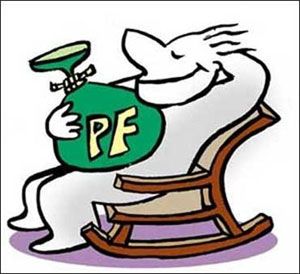But increase in the statutory contribution will boost retirement corpus For most employees, the first thing that comes to mind at the thought of social security is Provident Fund - a fund to which they contribute 12 per cent of their salary each month and hope of saving money for their old age.
For most employees, the first thing that comes to mind at the thought of social security is Provident Fund - a fund to which they contribute 12 per cent of their salary each month and hope of saving money for their old age.
Social security in India is administered under the Employees' Provident Funds and Miscellaneous Provisions Act, 1952 (the EPF Act).The EPF Act comprises three pillars - Provident Fund (PF), pension scheme and insurance scheme.
While the PF provides lumpsum payment on an employee's retirement, resignation or death, the pension scheme benefits her with monthly pension post retirement. As the name suggests, the insurance scheme provides life insurance cover to an employee.
The government has made radical changes to all the three schemes effective September 1, 2014.
Prior to September 1, 2014:
An employee with monthly salary of up to Rs 6,500 was a member under the three schemes. The membership was voluntary for an employee with monthly salary exceeding the limit of Rs 6,500.
Twelve per cent of the salary contributed by the employee was deposited fully into the PF. Matching contribution made by the employer was allocated as under: 8.33 per cent of Rs 6,500 per month into the pension scheme and balance to PF.
Salary for the purpose of calculating contributions was limited to Rs 6,500 per month unless the employer and employee had opted to contribute on a higher salary. Change from September 1, 2014:
Change from September 1, 2014:
The existing salary limit of Rs 6,500 has been increased to Rs 15,000, thereby expanding both membership base and the quantum of contributions.
Now an employee with monthly salary above Rs 6,500 but up to Rs 15,000 will also be covered under the three schemes. Unlike PF and insurance scheme, voluntary membership is not available under the pension scheme for an employee with monthly salary of above Rs 15,000.
With the new salary limit of Rs 15,000 for calculating contributions, the total contributions - both by the employer and the employee will increase. Earlier the contributions were limited on a salary of Rs 6,500.
The government has also fixed monthly pension benefit at Rs 1,000 for the financial year 2014-15 and increased the lumpsum benefit available on death of an employee by 20 per cent.
What these changes mean:
Nothing changes for those with a monthly salary of up to Rs 6,500, as both employer's and employee's contributions will still be mandatory and will be based on actual salary. Employees with monthly salary of up to Rs 15,000 who have not opted for voluntary membership earlier, will now be required to become members of all three schemes. Whether enrolled prior to or after September 1, both the employer's and employee's contributions will be on salary of Rs 15,000 unless an option is availed to contribute on a higher salary.
Employees with monthly salary of up to Rs 15,000 who have not opted for voluntary membership earlier, will now be required to become members of all three schemes. Whether enrolled prior to or after September 1, both the employer's and employee's contributions will be on salary of Rs 15,000 unless an option is availed to contribute on a higher salary.
For instance, Sovan Sarkar, who is an office helper with a multi-national company earns a monthly salary of Rs 12,000. Though he was already contributing Rs 780 per month (12 per cent of Rs 6,500) towards PF, now he will have to shell out an extra Rs 660 every month taking his contributions to Rs 1,440 each month (12 per cent of Rs 12,000).
Similarly, even his employer's contribution will increase to Rs 1,440 every month, which will be allocated as follows: Rs 1,000 (8.33 per cent of Rs 12,000) towards pension Scheme and the balance Rs 440 towards PF. The employer would deposit an additional Rs 60 (0.5 per cent of Rs 12,000) towards insurance scheme for Sarkar.
For employees earning monthly salary exceeding Rs 15,000, the membership is voluntary. For new members joining the scheme on or after 1 September 2014, the contribution is required to be made only under the PF and insurance scheme - as such employees are not eligible for membership under the pension scheme. Members limiting monthly contributions on salary of Rs 6,500 earlier will now have to contribute on at least salary of Rs 15,000.
Naveen Kumar, a young graduate in his first job, earns a monthly salary of Rs 20,000. Effective September 1, Naveen's savings will rise as the contributions will increase to Rs 1,800 (12 per cent of Rs 15,000) as employee's share to the PF, Rs 1,250 (8.33 per cent of Rs 15,000) as employer's share to the pension scheme and balance Rs 550 as employer's share to the PF.
For Hardip Singh, who earns the same salary as Kumar, but has taken up his first job after 1 September 2014, both the employer's and employee's share (12 per cent of salary each) will be allocated fully to the PF.
On a whole, in spite of a possible impact on the monthly take-home salary, the revision of statutory salary ceiling to Rs 15,000 may do wonders for retirement savings.
Illustrations: Uttam Ghosh/Rediff.com
Sonu Iyer is Partner & National Leader - Human Capital Services, EY and Puneet Gupta,is Senior tax professional, EY (Views expressed are personal)










